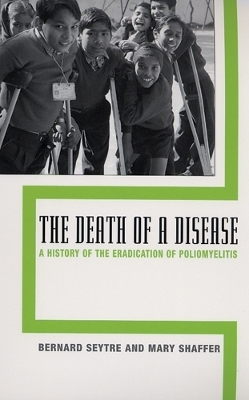
The Death of a Disease
A History of the Eradication of Poliomyelitis
Seiten
2005
Rutgers University Press (Verlag)
978-0-8135-3677-4 (ISBN)
Rutgers University Press (Verlag)
978-0-8135-3677-4 (ISBN)
In 1988, the World Health Organization launched a campaign for global eradication of polio. The goal is closer than ever as fewer than 2,000 people died from the disease in 2002, down from approximately 350,000 in 1988. In this book, the authors tell the story of this crippling virus that has struck down healthy children for centuries.
In 1988, the World Health Organization launched a campaign for the global eradication of polio. Today, this goal is closer than ever. Fewer than 1,300 people were paralyzed from the disease in 2004, down from approximately 350,000 in 1988.
In The Death of a Disease, science writers Bernard Seytre and Mary Shaffer tell the dramatic story of this crippling virus that has evoked terror among parents and struck down healthy children for centuries. Beginning in ancient Egypt, the narrative explores the earliest stages of research, describes the wayward paths taken by a long line of scientists-each of whom made a vital contribution to understanding this enigmatic virus-and traces the development of the Salk and Sabin vaccines. The book also tracks the contemporary polio story, detailing the remaining obstacles as well as the medical, governmental, and international health efforts that are currently being focused on developing countries such as India, Pakistan, Nigeria, and Niger.
At a time when emerging diseases and the threat of bioterrorism are the focus of much media and public attention, this book tells the story of a crippling disease that is on the verge of disappearing. In the face of tremendous odds, the near-eradication of polio offers an inspiring story that is both encouraging and instructive to those at the center of the continued fight against communicable diseases.
In 1988, the World Health Organization launched a campaign for the global eradication of polio. Today, this goal is closer than ever. Fewer than 1,300 people were paralyzed from the disease in 2004, down from approximately 350,000 in 1988.
In The Death of a Disease, science writers Bernard Seytre and Mary Shaffer tell the dramatic story of this crippling virus that has evoked terror among parents and struck down healthy children for centuries. Beginning in ancient Egypt, the narrative explores the earliest stages of research, describes the wayward paths taken by a long line of scientists-each of whom made a vital contribution to understanding this enigmatic virus-and traces the development of the Salk and Sabin vaccines. The book also tracks the contemporary polio story, detailing the remaining obstacles as well as the medical, governmental, and international health efforts that are currently being focused on developing countries such as India, Pakistan, Nigeria, and Niger.
At a time when emerging diseases and the threat of bioterrorism are the focus of much media and public attention, this book tells the story of a crippling disease that is on the verge of disappearing. In the face of tremendous odds, the near-eradication of polio offers an inspiring story that is both encouraging and instructive to those at the center of the continued fight against communicable diseases.
BERNARD SEYTRE is the author and coauthor of several books written in French. MARY SHAFFER is a professional science writer. Both authors are based in Paris.
Acknowledgments
1. The Last Victims
2. A Lifetime Burden
3. A Virus with a Long History
4. The People versus Polio
5. Freed from the Iron Lung
6. Coming Along at the Right Time: Jonas Salk
7. Behind the Scenes
8. The Largest Medical Experiment in History
9. The Race for an Oral Vaccine
10. Revolution in the Production of Vaccines
11. Polio: Programmed for Defeat
12. The End Game
13. The Challenge of Eradication
Notes
References
Index
| Erscheint lt. Verlag | 30.9.2005 |
|---|---|
| Verlagsort | New Brunswick NJ |
| Sprache | englisch |
| Maße | 140 x 216 mm |
| Gewicht | 227 g |
| Themenwelt | Medizin / Pharmazie ► Medizinische Fachgebiete ► Neurologie |
| Studium ► Querschnittsbereiche ► Epidemiologie / Med. Biometrie | |
| ISBN-10 | 0-8135-3677-4 / 0813536774 |
| ISBN-13 | 978-0-8135-3677-4 / 9780813536774 |
| Zustand | Neuware |
| Informationen gemäß Produktsicherheitsverordnung (GPSR) | |
| Haben Sie eine Frage zum Produkt? |
Mehr entdecken
aus dem Bereich
aus dem Bereich
ein überfälliges Gespräch zu einer Pandemie, die nicht die letzte …
Buch | Hardcover (2024)
Ullstein Buchverlage
CHF 34,95


